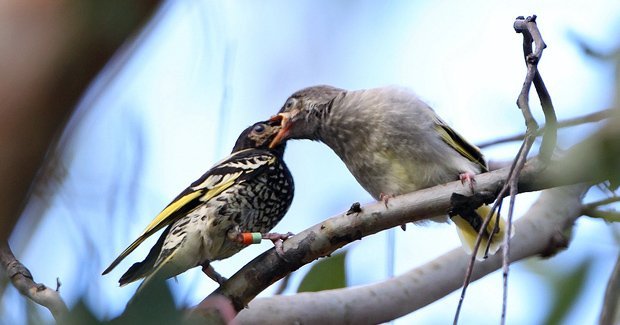Wild regent honeyeater chick a surprise find

CAPTIVE-BREEDING PROGRAMS ARE often the last resort to helping the survival of some endangered species, and they have their failures as much as successes.
After releasing an endangered regent honeyeater bird (Anthochaera phrygia) into the wild 14 months ago and losing track of it, scientists from Victoria’s Department of Sustainability and Environment (DSE) and Birds Australia figured the bird didn’t make it.
Imagine their surprise then, when the female, with its striking yellow and black feathers, turned up in a nest with a chick, in Chiltern, Victoria.
This is the first time a captive-bred honeyeater has born a chick in the wild.
“It’s fantastic,” says Birds Australia’s national regent honeyeater recovery co-ordinator, Dean Ingwersen. “We’re really buoyed by it…considering the amount of work we’ve put in.”
Wild honeyeater chick a significant boost to species
The discovery provides a significant bolster to the survival of the birds says Glen Johnson, senior biodiversity officer at the DSE.
“It means new genes and more numbers,” he says. “They’re a reasonably social species and they do well in a critical mass; they’re reliant on having numbers in their colonies.
Usually birds of a feather, regent honeyeaters were once seen in large flocks but their numbers are now down to fewer than a thousand nationwide. Pockets of them remain only in New South Wales and Victoria. The IUCN Red List classifies the species as Endangered.
Regent Honeyeater endangered due to land clearing
The regent honeyeaters’ decline has emerged over the last century because of land clearing destroying their habitat, Glen says.
Their decline is from “the ongoing legacy from the loss of habitats and fragmentation,” he says. “And the aggressive birds are also having an influence.”
Bully birds like the noisy miner and noisy friarbird have been frightening the honeyeaters, contributing to the stress of the birds, which results in decline of breeding, says Professor David Paton, expert in bird ecology at the University of Adelaide.
“Stress has the effect to reduce the bird’s ability to sequester energy,” he says.
As the honeyeaters are pollinators, their extinction would see a domino effect in their environment.
“It would probably be a symptom of a greater decline,” Dean says. “If you lose the regent honeyeater you may start losing other species and the wheels start to fall off the functioning ecosystem.”
Catch and release program sees regent honeyeater breeding
Over the last two decades wide collaborative efforts to revive the species has had some success in captive breeding releases and restoration of natural habitats.
Taronga Zoo has led the captive-breeding program, while Dean has co-ordinated the release of birds into the wild.
From a total of 80 birds released in 2000, 2008 and 2010, only six have been spotted by the team, Dean says.
While these numbers seem low, the discovery of this latest bird “brings a new perspective on the potential survival figures,” says Glen.
To track the birds’ movement, the scientists band them and attach radio transmitters to a few – but after a few months batteries often fall off and “we’re back to just hearing and seeing,” says Glen. This could mean that many more birds survive than their hard data suggests.
Satellite technology the key to the honeyeater’s long-term survival
Improvements to satellite technology – used in tracking larger animals like sharks and dingoes – would aid the team in expanding their knowledge of the bird’s movement patterns – a technology less than 10 years away, says Glen.
“This is ideal because we can get a season-to-season or day-to-day record of where they’re going, [but] they’re just too small a species right now.”
In the meantime, the focus is on repopulating the species through continued wild breeding from captive-breeds in order to get them through the next decade as they wait for re-vegetation of their habitat.
Dean says that this means their latest success isn’t going to see them rest on their laurels.
“We’re in a better position than we have been in a long time, but we’re not out of the woods yet, not by any stretch of the imagination.”
RELATED STORIES

